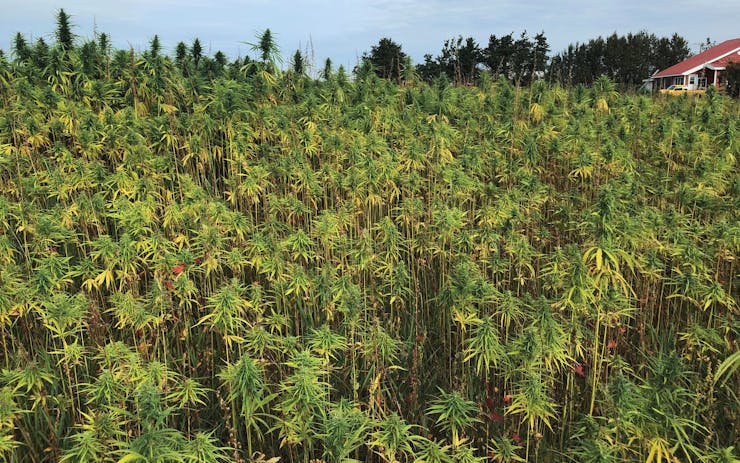This article is sponsored by Floraplex Terpenes, offering botanically derived terpenes and terpene blends to individuals and businesses alike.
In today’s terpene market, fruity flavors and sweet strains rule the roost, according to the team at Floraplex Terpenes, which marks terpene blends mimicking the makeup of Gelato and Fruity Pebbles OG as among their top sellers.
But trends come and go, especially in the cannabis industry. That’s why Floraplex keeps their research and development department busy developing new terpene blends, finding non-cannabis sources for terpenes, and conducting basic research on these molecules.
Inside the Terpene Lab
As the Floraplex science team starts to recreate the flavor of a new cannabis strain, or cultivar, they begin by conducting an analysis of the plant as a whole
“Our first step is to define the chemotype of whatever cultivar we’re looking at by analyzing its cannabinoid ratios, as well other chemical components like flavonoids and terpenes using data from gas chromatographs and other tools,” says Jared Mckenney, chief science officer for Floraplex. “While the terpenes are what we’re most interested in, taking a look at the context in which those terpenes occur is also important.”
Developing this full-plant profile doesn’t just help Floraplex understand modern strains. It also makes it possible for them to recreate vintage strains for which reliable data can be hard to come by.
“As we work to recreate classic cannabis strains like Acapulco Gold, understanding the lineage of the plant—what it was bred from, and what it’s been a parent to—are vital tools in mapping and replicating unfamiliar terpene profiles,” says Mckenney.
While Floraplex is working hard to bring new products to its lineup—the company has introduced over a dozen new flavors in 2019 alone —not all their research is conducted with commerce immediately in mind. When it comes to the booming terpene industry, there’s plenty of basic research left to be done.

Floraplex scientists work diligently to analyze the makeup of cannabis cultivars, (Yarygin/iStock)
Hunting for Hashishene
Among the more single-minded experiments that the Floraplex team is conducting right now is an ongoing hunt for non-cannabis sources of exotic terpenes such as hashishene.
“There’s this idea that hashishene is only found in hash, but in reality, it’s a degradation product of another terpene, myrcene, when it’s exposed to light causing photo-oxidation to occur. You find it in hash because the drying and pressing process creates the conditions for myrcene to break down into hashishene,” says McKenney. “But it’s not unique to hash. You can use myrcene from any plant, expose it to the proper conditions, and the result will be hashishene. And we’re starting to get a pretty good idea of how we can create those conditions in the lab, as well as what plants we might use as a source of myrcene.”
Hashishene isn’t the only exotic terpene the Floraplex team has been studying. They’re also exploring beta elemene. McKenney describes beta elemene as a novel among terpenes, which are often noted for their strong aromas and flavors, as being almost odorless and flavorless.
“It’s a very atypical terpene that we think could have some really interesting applications in the future. There’s almost no research that’s been done on it yet, but anecdotally, it seems that it could play a role in the entourage effect by modulating the effects of other terpenes,” McKenney says
How Basic Terpene Research Sets the Table
Another focus of the basic research Floraplex conducts, McKenney tells Leafly, is improving the efficiency of extraction techniques and their scalability. That’s a particularly tall order when it comes to extracting and preserving volatile molecules like terpenes.
Terpenes are notoriously fragile, and small changes in how source materials are treated can lead to big impacts in an extraction. Establishing protocols that increase extraction efficiency is a high priority for Floraplex as the company prepares to step into the growing market for terpenes derived directly from cannabis.
“We know that the next wave in sourcing terpenes is going to be from cannabis, starting with hemp. The issue we see there is that growers are focused on cultivating for cannabinoids, not for terpenes and cannabinoids,” says Floraplex CEO Alec Riffle.
Terpenes and The Hemp Industry
That’s why, in addition to conducting their in-house research, Floraplex is working to educate hemp cultivators about best practices for preserving terpenes to improve extraction down the line
“Some of these farms are producing hemp with high cannabinoid levels and lots of terpenes,” says Riffle. “But generally, they don’t value the terpenes, and as a result, the terpene samples we’ve seen from big hemp farms are degraded.”
Improving those processes could be key to the success of the recent and growing generation of hemp cultivators around the country. Terpene extraction, Riffle says, represents a great way for these farmers to add another source of revenue to their business model and set themselves apart in a competitive market.
“Back in the day, cultivators who were growing THC-rich cannabis often just threw away trim and popcorn nugs,” Riffle points out. “Then it became clear that those were valuable resources for extraction, and now, not a part of the plant is wasted—except for the terpenes. We’re proud to be doing the work to change that throughout the industry.”






